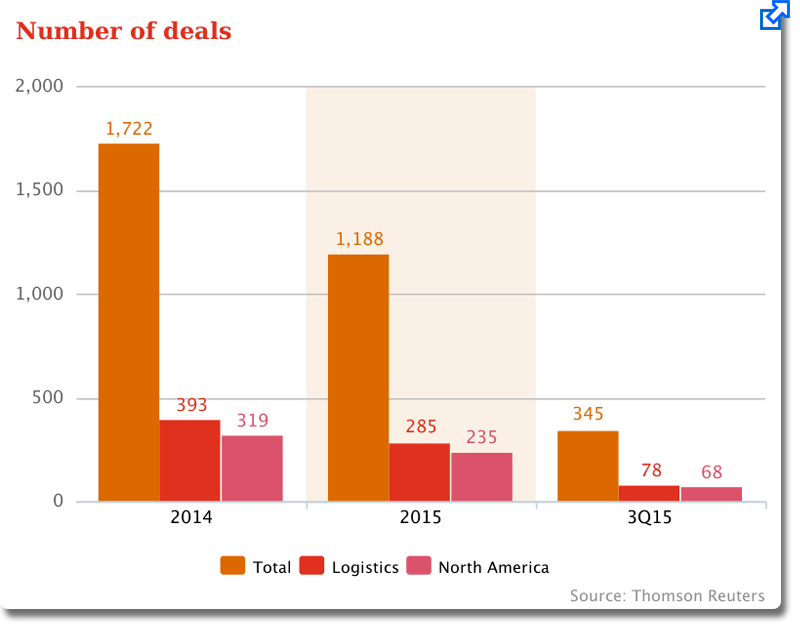Transportation and Logistics M&A in Good Shape through First Three Quarters of 2015
While third quarter transportation and logistics merger and acquisition (M&A) activity saw a decline, year-to-date deal making matched up well with recent years as deal value for the first nine months of 2015 hit its highest level going back to 2006, according to data issued by PwC this week.


Deals cited by PwC in its data report represent all announced deals for the quarter-as opposed to completed deals only-and the report does not parse out deals that are withdrawn, intended, or pending, and only deals valued at $50 million or more are included.
PwC said in the third quarter there were 44 transportation and logistics transactions valued at $50 million or more for a total value of $28.8 billion, which represented a 30 percent decline in deal volume and a 27 percent decline in deal value compared to the second quarter of this year and a 28 percent decline in deal volume and a 36 percent gain in deal value, due to average deal size increasing over the last four quarters, said PwC.
On a year-to-date basis, deal-making activity was steady annually, with value shooting up 55 percent compared to the same period a year ago from $63.1 billion to $97.9 billion.
In the third quarter, there were six megadeals, which PwC said are deals valued at $1 billion or more, cumulatively valued at $18.3 billion and accounting for 63 percent of total third quarter deal value.
PwC said these deals were spurred on by companies trying to increase scale, enhance operations, build transportation networks, and expand geographic reach.
Some other notable takeaways of the report included:

- Cross-border expansion was a key driver particularly in advanced economies, with more than half (55 percent) of the deals involved trans-national activity, and strategic investors looking to build a global transportation network and expand operations were involved in 48 percent of all cross-border deals for the quarter (and 52 percent of overall deal activity for the quarter);
- Financial investor activity was up to nearly 48 percent compared to 44 percent in the second quarter;
- Logistics companies represented 23 percent of T&L activity in the third quarter and that trend is expected to continue growing; and
- Marine shipping and related services deals drove more than a third of the quarter’s volume at 34 percent compared to 13 percent in the second quarter
PwC U.S. Transportation and Logistics Leader Jonathan Kletzel told Logistics Management there have been various drivers for the gains in deal volume and value in recent quarters.
“Despite a dip in deal activity in the third quarter, we continue to see interest in transportation and logistics M&A from companies across the board including logistics, trucking, shipping and other sub-sectors,” he said. “While executives may have pushed the pause button in the third quarter following a recent surge in consolidation over the last several quarters, activity for the year as a whole remains robust. In fact, in the first nine months of the year, T&L companies have already surpassed the total deal value for all of 2014.”
When asked what is driving the traction behind regional/local market deal-making activity, Kletzel said that, as in previous quarters, Asia and Oceania is the region that has accounted for the largest portion of deal activity - driven largely by the level of activity in China (half of the region’s deals).
In the past, he said PwC has seen the geographic focus on deal activity shift toward emerging markets such as China where there is still significant room for consolidation in sectors such as shipping and maritime services and logistics providers.
“A majority of the deals in this region tend to be local-market transactions, allowing companies to focus on strengthening their core businesses while emphasizing cost synergies given the tendency for overlap in transportation networks and existing operations,” he explained. “As China’s economy continues to expand, we expect to see these deals continue as companies seek opportunities for inorganic growth.”
As for cross-border activity, he noted that many of the completed cross-border transactions in the third quarter were intended to build a global transportation network and expand international operations and PwC expects to see this trend continue with advanced economy acquirers as they look to purchase more foreign entities in higher growth countries, coupled with expecting more emerging market acquirers to participate in trans-national activity as they grow large enough to begin to see merger opportunities internationally.
Recent: Transportation and Logistics Mergers & Acquisitions


Article Topics
PwC News & Resources
PwC and MAPI release survey on state of IoT in manufacturing ELFA survey of equipment finance activity reports new business volume grew 12.4% in 2015 Manufacturers turn cautious on global economic outlook, according to PwC US survey PWC report: Economic sentiment among manufacturers softens How omni-channel challenges impact costs, revenues and responsibilities PwC US: Manufacturers remain optimistic despite growing concerns around strong U.S. dollar Industrial manufacturing M&A value skyrockets past historic levels More PwCLatest in Materials Handling
Ergonomics Update: Hearing protection in the warehouse Parcel handling on the move An inside look at picking technologies April Services PMI contracts following 15 months of growth, reports ISM Where rack meets automation Comau’s Advanced Solutions Drive The Benefits Of Automation For Diversified Industries Toyota Industries Corporation launches Toyota Automated Logistics Group to house acquired companies More Materials HandlingAbout the Author
Subscribe to Materials Handling Magazine

Find out what the world's most innovative companies are doing to improve productivity in their plants and distribution centers.
Start your FREE subscription today.
April 2024 Modern Materials Handling

Latest Resources











